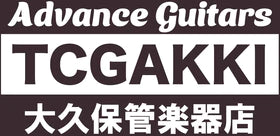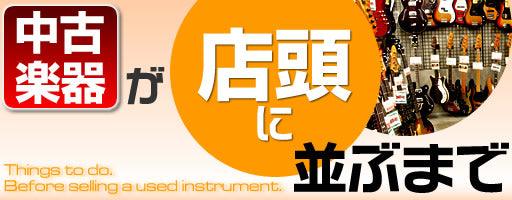

We, THE Used Musical Instrument Store, have had our store here in Shin-Okubo for more than 30 years. Thanks to your support, we now handle more than 16,000 used musical instruments per year. One of the most common questions we receive from our customers is "Where can I find used instruments? We are proud to answer such a question with our hearts. We proudly answer such a question: "Everything is used. We are very happy to hear this. If you are used to going to a new music store, you can come to our store and look at our used products without any sense of discomfort. It may not have the shine of a new one.
Although there are scratches, rust, and dullness that cannot be removed by any means, we polish, repair, and adjust our instruments every day with an awareness of cleanliness that is as good as that of a new instrument. Sometimes, we even find stains that make us want to say, "You buried it? We polish guitars with the hope that one day they will be given to the next owner. Have you ever seen these instruments lined up in a recycle store? Have you ever seen a guitar in a recycle shop with a bent neck, rusty strings, and dust? We often hear funny stories about how the cost of repairing a guitar at a recycle store is higher than the cost of buying it at a recycle store, but it is a matter of course for a specialty store to properly adjust and polish a guitar. As a specialty store, we strive to satisfy our customers not only with our products, but also with our value-added policies of "cleanliness" and "peace of mind that the guitar has been tuned".
The staff at THE Used Musical Instrument Store not only has a wealth of knowledge about used musical instruments, but they are also maintenance professionals and all love musical instruments. We adjust each guitar with high skills and warm hearts so that you can purchase it in the best condition possible.


Let us introduce you to the process from the time a guitar arrives at our store to the time it is placed on our store shelves.
This Fender '74 Stratocaster is about 35 years old, so it is quite old.

The bridge and fretboard surfaces are especially dirty.

First of all, let's play the sound.
Checking the condition of the neck and the electrical system before cleaning and adjustment will help us to take appropriate measures when disassembling.

First, wipe off any rough dust, etc. here.
A household cleaning tool called a "Quickle wiper" can be used. This is very convenient because it wipes off the dust quickly and does not return!
|
First polishing. Roughly remove dirt from the entire surface. |
|
|
|
Next, remove the strings. |
|
|
|
Remove the pegs as well. |
|
|
|
I can't believe I have to take it all apart! ...At first glance, it looks like a lot of work, but it is more efficient and more finished than polishing the pegs by sewing in the gaps between them. |
|
|
|
Second polishing. Polishing from the head and body to the smallest parts. |
|
|
|
THE Used Musical Instrument Store has two types of cloths. The one on the left is a general "silicon cloth". The one on the right is the "Hyper Micro Cloth. |
|
|
|
Can you see the difference in fineness? Micro cloth is made of ultra-fine fibers processed with advanced fiber technology, and the fibers themselves are easy to wipe off dirt. It is recommended to have a micro cloth at home. |
|
|
|
The pegs are also carefully polished one by one. |
|
|
|
Use cotton swabs for small parts. |
|
|
|
The pegs are now shiny and clean. It is obvious at a glance compared to before polishing. |
|
|
|
Next, the frets are polished. We use "Solar Rubbing Compound" which is a very fine compound for professional use. |
|
|
|
Stir well and polish. |
|
|
|
A small amount of the compound is put on a cloth and polished one fret at a time so that it does not get into the crevices of the frets. |
|
|
|
For rose fretboards, use masking tape to avoid getting into the conduit of the wood. |
|
|
|
Behold! This is a high speed scratch! Any rust can be cleaned to a shine! |
|
|
|
Scratch out the dust between the frets. |
|
|
|
You can see how shiny it is compared to before polishing. |
|
|
|
The pick guard is also removed and polished. We do not cut any corners. |
|
|
|
Dirt can get in between the pick guard and the body. |
|
|
|
We polish it so as not to damage the paint. |
|
|
|
Hi, it's clean now. It is now clean. |
|
|
|
Stamped gray bobbin pickups, CTS pot dates. Ceramic capacitors and CRL switches...............................original parts are also checked. |
|
|
|
Dirt collects on the sides of the pickups. |
|
|
|
Carefully remove the dust so as not to cut the wire. |
|
|
|
The electrical system will also be checked. |
|
|
|
Next, the bridge. |
|
|
|
Again, this is also disassembled. Be careful not to lose any small original parts! |
|
|
|
Polish the screw heads. |
|
|
|
Remove dust and dirt from inside the spring. |
|
|
|
Polish all 6 strings including screws, comas, and springs. |
|
|
|
The bridge plate is also polished to this shine! It took about 40 minutes up to this point. |
|
|
|
This is the end of the polishing process. Almost all the dark spots on the fingerboard are gone. |
|
|
|
|
|
Third polishing. The final step is to polish the fingerboard with wax. |
|
|
|
Do not scrub too much so as not to damage the paint! This will bring back the gloss. |
|
|
|
Then, we put the strings on and we are done........ |
|
|
|
We adjust the neck, string height, octave, etc. We make adjustments to the neck, string height, octave, etc., so that the instrument is as easy to play as possible, with the next user in mind, and so that the potential of the instrument is brought out to its fullest. |
|
|
|
|
|
|
|
|
|
|
|
The polished and adjusted guitars must pass a strict check by the person in charge of guitars, not by the devil sergeant of THE used music shop. |
||
|
|
|
|
|
This time, the first check was a complete NG.... The adjustment of the guitar was good, but the polish was not good enough. How harsh! |
|
|
|
Re-polishing with fire! How about this time! |
|
|
And...
|
After all this work, we finally got the OK! We were now able to put the product on the shelves. |
|
|

Of course, some of the instruments we handle do not need this much work, and some we do not know where to start. But no matter what condition they are in, we are always trying our best to work with them. We fight against the limits of repair costs, but we never give up. We will find the best solution for any instrument, adjust it to the best condition possible, and deliver it to you.
Because even if it is one of hundreds of guitars for us, it is one of the most important guitars for the customer who will own and play it next. We consider ourselves professionals only when we go this far.










































